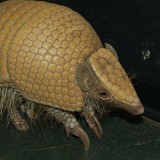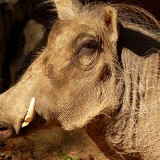RANGE
Southwestern Madagascar
HABITAT
Deciduous forests to arid brush/forest.
SIZE
Ring-tailed lemurs are about 1 meter in length with more than half of their length being the tail.
Head and body: 385–455 millimeters or 17 ¾ inches
Tail: 560–624 millimeters or approximately 21 ½ inches
Weight: 2.5–3.5 kilograms (5 ½-7 ½ lbs)
REPRODUCTION
- Ring-tails are sexually inactive for most of the year. Females come
into season from April to June. Births generally occur from August to November after a gestation period of 136 days. It is unusual to give birth to more than one offspring at a time; however, on rare occasions they have been known to produce twins and even triplets. - Young are born well haired and with eyes open. Offspring are usually independent at around six months. Infants may suckle until they are five months old, but begin to take solid food in the second month. Babies will cling to their mother’s belly for the first two weeks of their life and as they gain strength will begin to ride on their mother’s back.
- Young are raised by the entire group. Mothers frequently exchange their babies and care for related offspring. At birth the babies’ eyes are blue and later the iris turns into a brilliant yellow.
- Sexual maturity is reached within a two year period with females having the ability to conceive at the age of 19 ½ months. Males are sexually mature at 19 – 20 months; however, it is not until they are around 2 ½ years old that they will be able to compete with older males and be allowed to mate.
DIET
- Wild: Mostly fruits, some leaves and other plant material. Rarely insects.
- Zoo: Vegetables, fruits, monkey biscuits.
- Lemurs get most of their moisture from the foods they eat and are seldom seen drinking water.
BEHAVIOR
- They are primarily diurnal and very territorial. Ring-tailed lemurs are the
most gregarious of lemurs, traveling in groups of 5–30. Groups are organized around a core of adult females and their infants, juveniles and sometimes one or more dominant male. There is usually no constant leader of the troop, but adult females dominate others and appear to be responsible for territorial defense. Males are generally peripheral to group activity. Females are dominant and respected by males. - Dominance hierarchies exist in larger groups with separate ranking orders among the females and the males.
- Troops have well defined overlapping territories within their home range. Upon meeting, opposing groups solve territorial disputes by running at each other and vocalizing. Rarely will there be any physical contact during territorial disputes.
- Researchers have recorded as many as 15 different vocalizations including a howl that can be heard up to 1000 meters away.
- Ring-tails use scent to mark their territories. They possess a hairless glandular region on the inside of the lower arm, just above the wrist and on the shoulder. Males have an additional gland on the upper arm, which secretes a strong smelling fluid. Ring-tailed lemurs will draw their tails across these glands and flick the tails dispersing the scent. Lemurs will also spray urine to disperse scent and mark territories. Ring-tails will mark every foreign object in their territory. Males have bony spurs on their wrists near the glands, which can be used to rub small trees leaving a slash in the bark, impregnated with scent. The “click” from the scratching of these spurs can be heard from some distance away. Lemurs will also soak their tails with the scent and wave it in the direction of rival lemurs during display rituals.
POINTS OF INTEREST
Ring-tailed lemurs can often be seen sunning themselves by sitting upright with arms out-stretched. This unusual position was thought to be “praying” by early inhabitants of the island, which led to the belief that lemurs were “religious creatures” or “sun worshippers.” This belief helped protect these creatures for many years since islanders refused to harm them. Another belief arose that lemurs were the living spirits of dead ancestors, thus they were given the name “Lemur”, which is Latin for “ghosts.”
Ring-tails are mainly ground dwellers, but they are very well adapted to arboreal movement. Ring-tails can jump effortlessly up vertical walls to a height of about three meters. Small ledges are sufficient for gaining a hold and propelling themselves. Wide, soft, toe pads help in gripping both trees and rocks. Ring-tailed lemurs, as in most lemurs, have nails on all digits except the index toe, which contains a sharp claw, used for grooming. Lower incisor and canine teeth lean forward and are flattened to form a “comb” which is used to rake or comb the fur. A long, horny filament under the tongue is used to scrape accumulating dirt out of the teeth.
REFERENCES
- Grzimek’s Animal Life Encyclopedia. Dr. Dr. h. c. Bernard Grzimek, Editor. V. 10, pp. 281–290.
- The Audubon Society Encyclopedia of Animal Life. 1987 edition. pp. 35–37.
- Macmillan Illustrated Animal Encyclopedia. 1984, pp. 56–57.
- Madagascar Lemurs: on the edge of survival. Allison Jolly, National Geographic, August 2008.
- Walker’s Mammals of the World. V. 1, Ronald M. Nowack.
- www.iucnredlist.org/details/11496/0







